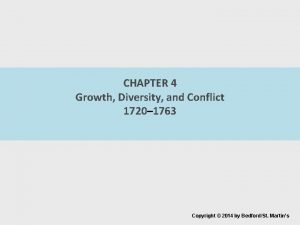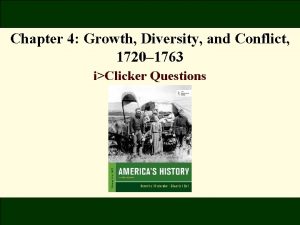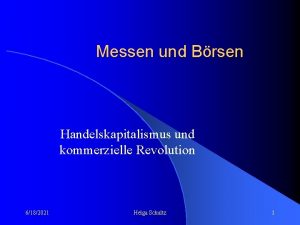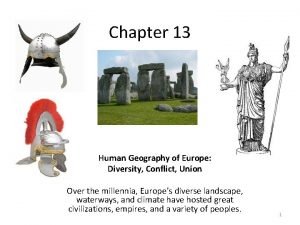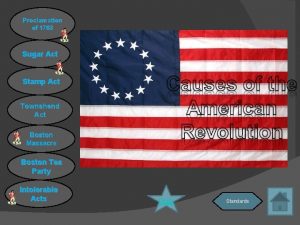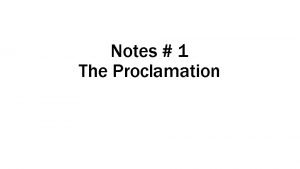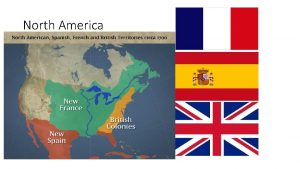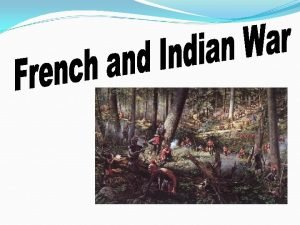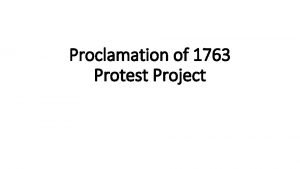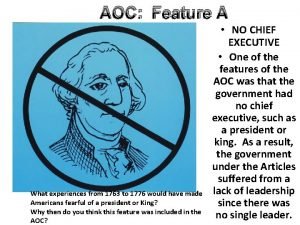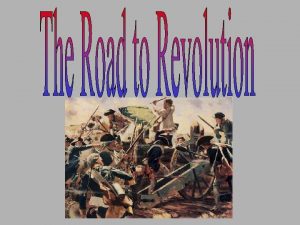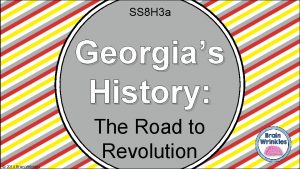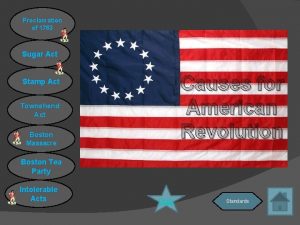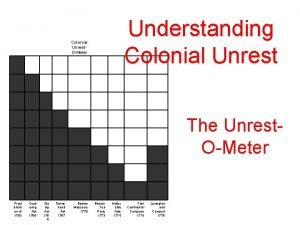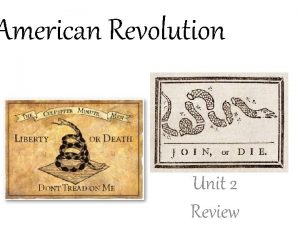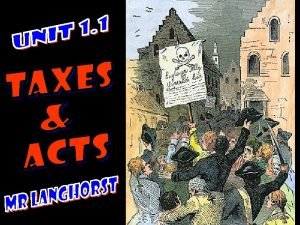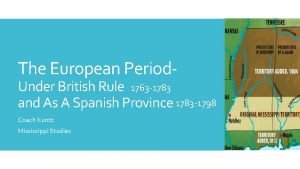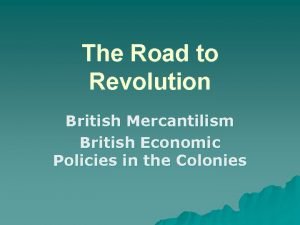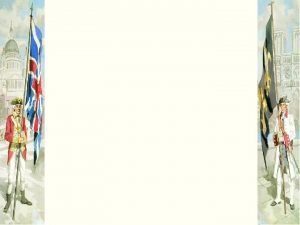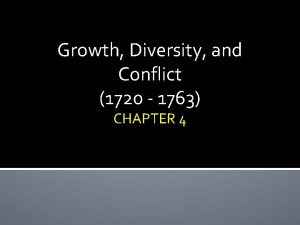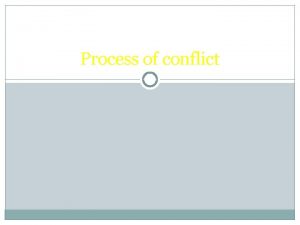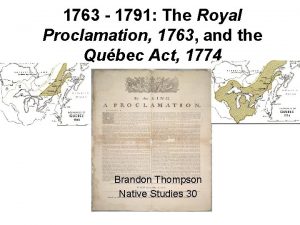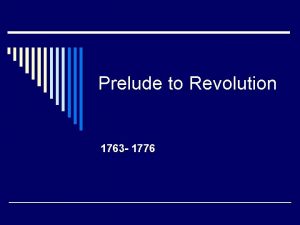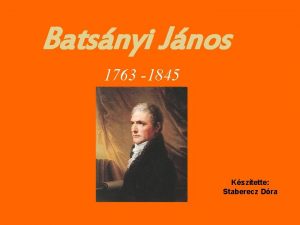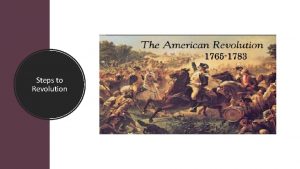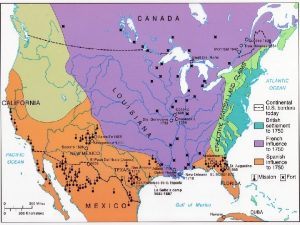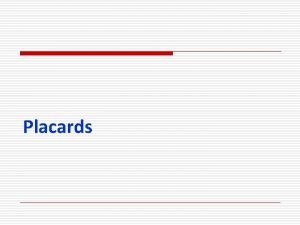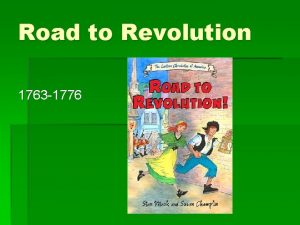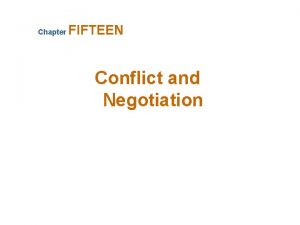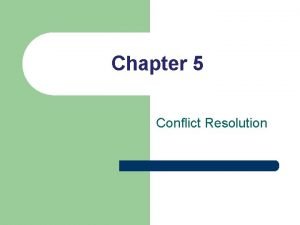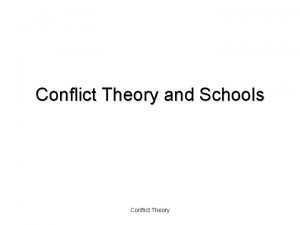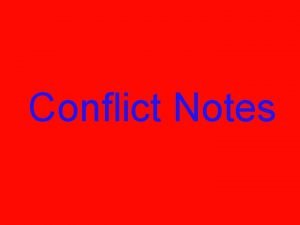CHAPTER 4 Growth Diversity and Conflict 1720 1763

































- Slides: 33

CHAPTER 4 Growth, Diversity, and Conflict 1720– 1763 Copyright © 2014 by Bedford/St. Martin’s


I. New England’s Freehold Society A. Farm Families: Women in the Household Economy 1. Husband the head of the household - girls learned from their mothers to be subordinate to their fathers. 2. Wife seen as the dutiful “helpmate. ” 3. Motherhood -Most women married in their early twenties and had given birth six or seven times by their early forties. 4. Restrictions - No equality for women within the church; most women accepted such restrictions as social norms.


I. New England’s Freehold Society B. Farm Property: Inheritance 1. Family authority- landless children could be placed as indentured servants until age 18 or 21; landless men hoped to climb from laborer to tenant to freeholder. 2. Children of wealthy parents - parents to choose their children’s spouses because economic concerns outweighed love in the long-term interests. 3. Marriage - Bride gave her husband legal ownership of her property; she received a dower right to use but not sell one-third of the property if her husband died. 4. Father’s duty - Was to provide an inheritance for his children or lose status in the community.

I. New England’s Freehold Society C. Freehold Society in Crisis 1. Population increase - Rapid natural increase doubled New England’s population each generation, this resulted in the division and subdivision of family farms to 50 acres or less. 2. Changes in family life - Couples tried to limit family size or moved their new families into the frontiers of central Massachusetts, western Connecticut, and New Hampshire and Vermont. 3. “Household mode of production”-System of community exchange in which families swapped labor and goods.

II. Diversity in the Middle Colonies A. Economic Growth, Opportunity, and Conflict 1. Tenancy in New York - landowners granted long leases and the rights to sell improvements (houses, barns) to subsequent tenants. 2. Conflict in the Quaker Colonies - Early Quakers had settled in Pennsylvania and New Jersey, building simple homes and getting by with little. By the 1760 s, wealthy landowners in eastern Pennsylvania were using slaves and poor immigrants on their farms. This growing divisions between the social classes in the region.



II. Diversity in the Middle Colonies B. Cultural Diversity 1. Religious and ethnic diversity – Quakers were pacifists purchased land from Native Americans rather than seizing it; advocated the abolition of slavery. 2. The German Influx - discouraged from marrying outside of their ethnicity; advocated married women having the legal right to hold property and write wills. 3. Scots-Irish Settlers - Some were Irish and Catholic, but most were Scots and Presbyterians who had faced religious and economic repression by the English; settled in Pennsylvania region for religious tolerance.


II. Diversity in the Middle Colonies C. Religion and Politics 1. Religious diversity - Orthodox church officials of several religions brought intolerance to the colonies. As Quaker population declined by 1750 s, religious groups seeking increased political power (Lutherans and Baptists) had bitter conflicts raging among them.



III. Commerce, Culture, and Identity A. Transportation and the Print Revolution 1. Improved transportation networks - colonies transformed by dramatic increases in shipping in the north Atlantic and construction of new networks of roads 2. Print revolution - Publications crossed the Atlantic and colonies began to create their own new publications, which facilitated the development of colonial identity and solidarity.

III. Commerce, Culture, and Identity B. The Enlightenment in America 1. The European Enlightenment - Emphasized the power of human reason. 2. John Locke - English philosopher; wrote Essay Concerning Human Understanding, stressing the importance of environment and experience on human beliefs and behavior but argued that change was possible through education. 3. John Locke - Two Treatises on Government, stressing that if a government did not protect the natural rights of the people, they have an obligation to change it—as seen in the Glorious Revolution.

III. Commerce, Culture, and Identity • 4. Franklin’s Contributions - shaped by Enlightenment literature and not the Bible. Franklin became a “deist” and believed that a Supreme Being (Grand Architect) had created the world and then allowed it to operate by natural laws but did not intervene in people’s lives.

III. Commerce, Culture, and Identity C. American Pietism and the Great Awakening 1. Pietism - An evangelical Christian movement that stressed a personal relationship with God. 2. New England Revivalism - In the 1730 s, Jonathan Edwards in the Connecticut River Valley preached the helplessness of men and women; his sermon, “Sinners in the Hands of an Angry God. ” 3. Great Awakening - Whitefield’s spoke about the power of God and his “Free Gift of Salvation. ” followers were called “New Lights” for their claim that they felt a new light in them after hearing Whitefield preach.

III. Commerce, Culture, and Identity D. Religious Upheaval in the North 1. Old Lights and New Lights - Old Lights (conservative ministers) condemned the crying and fainting of New Lights in revival meetings and the New Light practice of women speaking in public; New Lights withheld tax payments from Old Light churches. 2. Challenges to authority - Great Awakening challenged authority of all ministers; gave new sense of authority to the many who felt more justified in expressing religious and political opinions.


III. Commerce, Culture, and Identity E. Social and Religious Conflict in the South 1. The Presbyterian Revival -New Lights challenged the Church of England in the South; ritual displays of wealth became less meaningful as competition existed between the churches 2. The Baptist Insurgency - In the 1760 s, thousands of white farmers converted to Baptist (adult baptism). Whitefield encouraged slaveholders to bring the enslaved to church, but many whites opposed; free blacks in Virginia embraced the church’s teachings. Ministers spread teachings among slaves and began to shrink the religious cultural divide between white and black prople.

IV. The Midcentury Challenge: War, Trade, and Social Conflict, 1750– 1763 A. The French and Indian War 1. Conflict in the Ohio Valley - In the 1750 s, French authorities, alarmed by British inroads into Ohio, build a string of defensive forts 2. The Albany Congress - In June 1754, delegates from British colonies met in Albany to discuss relations with the Iroquois and French expansion. 3. The War Hawks Win - Rising British statesman William Pitt in England wanted a war in North America with the French; fighting began June 1755; expanded to Europe by 1756 with Britain vowing to destroy France’s ability to compete economically.



IV. The Midcentury Challenge: War, Trade, and Social Conflict, 1750– 1763 B. The Great War for Empire 1. The French Indian War - Pitt directed the war successfully from England, controlling both the commercial and military strategies. The Treaty of Paris of 1763 ending the war gave Britain control of over half of North America, including French Canada. 2. Pontiac’s Rebellion - the Ottawa chief Pontiac, with a group of loosely affiliated tribes, launched an uprising against the British. Though Pontiac’s rebellion was put down, the Proclamation of 1763 prohibited white settlement west of the Appalachians. This edict was largely ignored by colonists.



IV. The Midcentury Challenge: War, Trade, and Social Conflict, 1750– 1763 C. British Industrial Growth and the Consumer Revolution 1. Resources -Since 1700, Britain had become the dominant commercial power in the Atlantic and Indian oceans. Mechanical power was key to Britain’s Industrial Revolution. 2. American consumers - Soon Americans were purchasing 30 percent of all British exports. To pay for British manufactures, mainland colonists exported tobacco, rice, indigo, and wheat. profits from exports enabled colonists to buy goods from England.

IV. The Midcentury Challenge: War, Trade, and Social Conflict, 1750– 1763 D. The Struggle for Land in the East 1. Land disputes - Rising population of colonies meant more land needed; disputes over land tenant uprisings broke out in Hudson River Valley of New York, in New Jersey, and in some southern colonies. Courts favored wealthy landowners; increasingly, the landless moved west to the Appalachian Mountains region.



IV. The Midcentury Challenge: War, Trade, and Social Conflict, 1750– 1763 E. Western Rebels and Regulators 1. The South Carolina Regulators - Anglo-American and Scottish settlers in South Carolina clashed with Cherokee; so-called Regulators were vigilante landowners who demanded that South Carolina’s eastern -controlled government provide western districts with more courts, fairer taxation, and greater protection and representation in the assembly; they were unsuccessful. 2. Civil Strife in North Carolina - tobacco prices fell. To avoid losing their land, mobs of farmers (also called “Regulators”) closed the courts and intimidated judges; the regulators proposed a series of reforms. Violence ensued, ending with 30 dead and 7 leaders executed.

Big Ideas • How were the economies of the colonies of the New England, Middle, and Southern Colonies similar and different? • How was the French Indian War a catalyst for the American Revolution?
 Chapter 4 growth diversity and conflict
Chapter 4 growth diversity and conflict Chapter 4 growth diversity and conflict
Chapter 4 growth diversity and conflict Kommerzielle revolution
Kommerzielle revolution Pluronic pe 10500
Pluronic pe 10500 Chapter 13 diversity conflict union
Chapter 13 diversity conflict union What is ecosystem biodiversity
What is ecosystem biodiversity Genetic diversity vs species diversity
Genetic diversity vs species diversity Proclamation of 1763 picture
Proclamation of 1763 picture What did the proclamation of 1763 forbid
What did the proclamation of 1763 forbid Proclamation of 1763
Proclamation of 1763 Queen anne's war
Queen anne's war Ohio river valley 1763
Ohio river valley 1763 Proclamation of 1763 protest
Proclamation of 1763 protest What experiences from 1763 to 1776
What experiences from 1763 to 1776 Proclamation of 1763
Proclamation of 1763 Proclamation of 1763 caricatures
Proclamation of 1763 caricatures Proclamation of 1763
Proclamation of 1763 First nations attack fort michilimackinac 1763
First nations attack fort michilimackinac 1763 Thomas barnard sermon massachusetts 1763
Thomas barnard sermon massachusetts 1763 Proclamation of 1763
Proclamation of 1763 Quartering act definition
Quartering act definition Proclamation of 1763
Proclamation of 1763 Why did the colonists hate the proclamation of 1763
Why did the colonists hate the proclamation of 1763 Under british rule, 1763-1783
Under british rule, 1763-1783 Navigation acts 1763
Navigation acts 1763 Map of north america 1763
Map of north america 1763 Define growth analysis
Define growth analysis Primary growth and secondary growth in plants
Primary growth and secondary growth in plants Primary growth and secondary growth in plants
Primary growth and secondary growth in plants Chapter 35 plant structure growth and development
Chapter 35 plant structure growth and development External conflict definition
External conflict definition What is conflict and conflict resolution?
What is conflict and conflict resolution? Internal conflict definition
Internal conflict definition Step growth polymerization vs chain growth
Step growth polymerization vs chain growth
